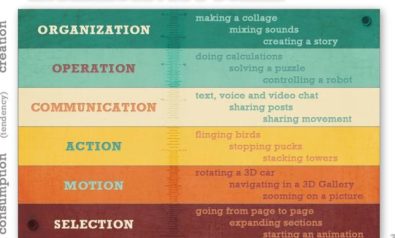A voyage from contemplation to interactivity.
When one thinks about a piece of fine art, Rembrandt, Kandinsky, or Picasso could come to mind. How involved can you get though by simply viewing one of their paintings? To what extent can we be entrenched in the meaning of a piece simply by viewing it?
With Rembrandt, you usually admire a beautiful portrait: so realistically rendered, thanks to his fine drawing style and colouring technique that you almost feel as if you were witnessing the scene. At best you imagine a story around the picture, and allow the mind to wonder. It gets trickier when you look at a modern painting, where the artist won't merely mirror a "thing" the way nature offers it to our eyes to see, but rather represents it the way he "feels" or "thinks" it. Instead of reproducing nature itself, the modern artist reproduces his idea of it, adding a subjective dimension. In her Biography "Out of this century" Peggy Guggenheim recalls a scene that fits quite well with these findings: "a man came and complained that one of the Cubist paintings did not resemble a man. Putzel [her secretary in her New York gallery]was indignant and told him that if he wanted to see a man he should go and look at one."
Opening-up Communication Spaces
Modern art, produced during 1860s to the 1970s, opened up room for interpretation to the public, who were required to become more involved and exert a supplementary intellectual effort. Imagination was now challenged: one could wonder about the perspective or the colouring the artist chose and one could wonder about what It--the subject of the painting–actually was. Though work-titles may give an indication regarding that last aspect, the scope for analysis is ample. Even more so when titles are as explicit as, for example, Red Spot II.
In "The open work" (1962), Umberto Eco speaks of the aspect of the Informal, which helps enter a richer communication in modern art, challenging the equilibrium of order within an oeuvre – a progress which he qualifies as installing "merest order within […]maximum disorder". Then emerge the "unexpected" and the illusion of anarchy which favour "openness" in the work and allow dialogue. Modern art therefore is a step towards a more active involvement by the public. Modern art can be likened to an open-ended story, it can be frustratingly inconclusive, yet offers the possibility of indefinite interpretations.
Throning in Finality
In order to speak of interactivity, does it suffice to open up space to the mind? In modern Art, the objective appearance of the artwork is still once and forever pinned down to its final aspect. The oeuvre is finished and inalterable.The artist remains master of his work and does not yield an inch of his supremacy to the public. In fact, he is even more so a master as, merely adding a riddle-aspect to his work. Only he holds the key to understanding. One may appreciate his work, one may use one’s imagination, but in the end one constantly wonders about the artist’s intentions. Umberto Eco also speaks of the pedagogic mission of the modern artist, which is to educate the bourgeois public and show them the value of "openness" by means of unexpected or unclear outcomes. In the eyes of the artist, the public has not yet reached adulthood and needs guidance. The artist retains the throne of supremacy, an image which the surrealist Max Ernst took quite seriously, by literally receiving guests and admirers in that fashion.
On The Playground
To qualify something as truly interactive though, mind-games don't suffice. But at what point may art claim to be thus? One may say that this point is reached at the moment, the artist is ready to let go of the idea of the ideal work. He is satisfied to merely providea structure that the public may alter. His work is bound to live in the moment, constantly altering in its aspects, yet being specific enough to be recognizable. This draws a line to performance, and abandons the ideas of eternity and materiality. Art is bound to become a tool to the spectator, who may toy around with the provided structures, ever re-creating them. In a way, art becomes democratic. It is therefore not surprising that 1968 was of special importance to the idea of art and interactivity. The slogan "Les murs ont la parole", meaning the walls can speak, applied to a series of poetic graffiti’s in Paris at the time and had an important impact on the perception of art: being free in ‘68 meant being able to participate. Henceforth, within the public, the place of the spectator in all the arts was questioned, and paved the way to interactivity with the environment.
For more than 10 years, Fair Observer has been free, fair and independent. No billionaire owns us, no advertisers control us. We are a reader-supported nonprofit. Unlike many other publications, we keep our content free for readers regardless of where they live or whether they can afford to pay. We have no paywalls and no ads.
In the post-truth era of fake news, echo chambers and filter bubbles, we publish a plurality of perspectives from around the world. Anyone can publish with us, but everyone goes through a rigorous editorial process. So, you get fact-checked, well-reasoned content instead of noise.
We publish 2,500+ voices from 90+ countries. We also conduct education and training programs on subjects ranging from digital media and journalism to writing and critical thinking. This doesn’t come cheap. Servers, editors, trainers and web developers cost money.
Please consider supporting us on a regular basis as a recurring donor or a sustaining member.
Support Fair Observer
We rely on your support for our independence, diversity and quality.
Will you support FO’s journalism?
We rely on your support for our independence, diversity and quality.








